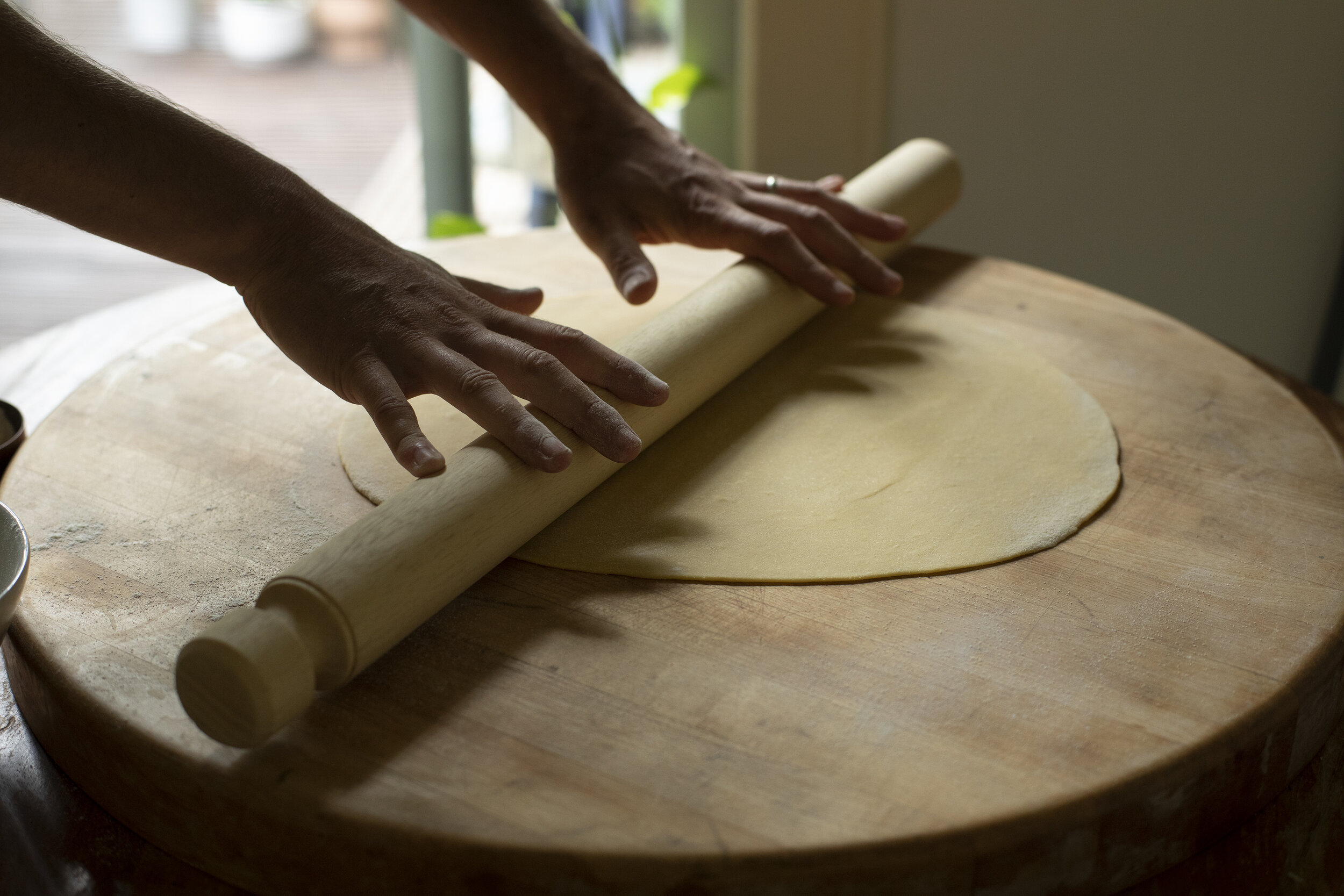Farfalle with Scape + Basil Pesto with Sautéed Chanterelles
Farfalle with a creamy basil + scape + toasted pine nuts + pecorino pesto topped with sautéed chanterelles foraged earlier in the morning. Pasta dough blended 75% 0 Manitoba flour from @mulinocaputo and 25% Semola Rimancinata Cuore from @molini_del_ponte_drago @gustiamo . Pretty killer combination using the best of what’s in season right now. Recipe as follows and a short video of the process below.
The Farfalle
Ingredients
300 g 00 Flour
150 g Semola Rimancinata Cuore
250 g eggs (beaten before mixing)
*Portioned for 5 - 6 people
Directions
Mix the flours and dump out the weighed amount onto a clean work surface.
Use your hand to form a well (like a volcano) in the center of the flour.
Carefully pour your eggs into the center and begin slowly mixing together with a fork. Gradually, carefully, work your way all around to incorporate the eggs with the flour, without breaking the outer wall. A bench scraper is a handy tool to have at this point if you have one.
After about 5 - 10 minutes it will start coming together into a shaggy mass. Begin using your hands to knead the dough together. Work diligently for another 5 minutes until it is no longer shaggy.
Use the edges of your hands, knuckles, to work the dough until it starts to form a smooth ball. Knead it, applying pressure, into the work surface. Fold it. Knead it again. After about ten minutes it should be smooth and ready to rest.
Cut the dough into two and wrap each in plastic wrap. Set into the fridge for at least 30 minutes.
The following steps revolve around using a mattarello (Italian rolling pin) - but you could also do this with a pasta machine. Remove one of the dough balls, unwrap, and place in the center of your work surface. Apply a light dusting of flour to both the surface and the top of the dough.
Slowly apply downwards pressure with the rolling pin, starting from the center of the ball and moving outwards. Repeat, methodically, always working from the center outwards. The sfoglia (pasta dough) will gradually begin to flatten and create a large round sheet on your work surface. If you’re finding the dough sticky, use a tiny bit more flour. Periodically flip the dough over and work from the other side. This process requires a little elbow grease and about 10-15 minutes of your time. You’ll know you’re done when the dough stops pulling inwards on itself and the thickness is about 2-3 mm. It should be light and delicate but be able to retain it’s shape. Allow the dough to air dry for about 5 minutes. Dust with a very light sprinkling of semolina.
For the next part of the process I highly recommend watching the video below. Using a pasta cutter, cut the sfoglia into rectangles about 1 inch wide by 2.5 inches long (or approximate a pinky length). Traditionally you’ll use a serrated cutter but you’ll notice in the video that I forgot in my haste so my farfalle has smooth edges. Use three fingers, one placed in the center and two on the outer central edges of the narrower side. Gently, firmly pinch from the outside in and slowly lift the center finger and press the edges together. Lift and place to the side to allow to air dry for another 30 mins to an hour. Repeat until you have finished all the rectangles and save the outer scraps for maltagliati. Take out the other dough ball and repeat the whole process.
The fresh pasta will cook in about 3-4 minutes in you boiling salted water.
The Pesto
Ingredients
Large bunch of basil
3-4 garlic scapes
Half a cup of pecorino Romano
3/4 cup of good olive oil
Pinch of salt
1/2 cup of toasted pine nuts
Directions
I kept this very simple and just used a food processor - combined all the ingredients and blended in about 30 seconds. The true way to do pesto is to use a mortar and pestle if you have the time and energy. I had a full day of foraging and making pasta and decided the pesto needed to be easy. With the addition of the pecorino this pesto is super creamy and decadent.
The final dish
Before cooking the pasta, clean and slice your chanterelles into a manageable size. I sauteed mine in olive oil with a little fresh thyme, salt and pepper until they were well browned and significantly reduced in size - which took about 8-10 minutes. You want to make sure your mushrooms are well cooked. Set aside.
After draining the cooked pasta (always reserve extra pasta water in case you need to thin out the sauce/pesto), immediately toss the pasta with the pesto and stir so they are completely coated. Mix in your wild mushrooms and toss together.
Serve into individual bowls and finish with some freshly grated pecorino Romano.
Enjoy.




















